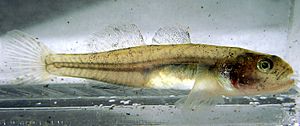Northern tidewater goby facts for kids
Quick facts for kids Northern tidewater goby |
|
|---|---|
 |
|
| Conservation status | |
| Scientific classification | |
| Synonyms | |
|
Gobius newberryi Girard, 1856 |
The Northern tidewater goby (scientific name: Eucyclogobius newberryi) is a small fish. It lives in calm waters like lagoons, marshes, and creeks. You can find them along the coast of California, United States. This goby is one of six types of goby fish found only in California.
Contents
What's in a Name?
The scientific name Eucyclogobius newberryi has a special meaning. The first part, Eucyclogobius, means "true cycloid goby". This refers to the type of scales the fish has. The second part, newberryi, honors a person named John Strong Newberry. He was an American geologist and explorer. He collected fish for the scientist who first described this species, Charles Frédéric Girard.
About the Tidewater Goby
Appearance and Size
The northern tidewater goby is a small fish. It is usually less than 5 cm (2 inches) long. It has a long body and a blunt tail. Its color can be gray, brown, or olive, often with a mottled pattern. When alive, these fish can look see-through.
Like many fish, they use camouflage. Their back is a bit darker than their belly. This helps them blend in with the water from above and below. The first fin on their back is clear or cream-colored. The second back fin is longer than the first. It is also similar in size to the fin on their underside.
Unique Features
The goby has a large mouth that points upwards. It can open wide, even past its eyes. Its eyes are set far apart on its head.
Most gobies have rough scales. But the northern tidewater goby has smooth scales called cycloid scales. They do not have scales on their head. Often, they don't have them on their belly either.
Color Changes
When it's time to breed, these fish change colors. Males become darker, almost black, with white spots. Females turn tan or reddish-brown. Their sides might become golden or dark-brown. Females can also get darker if they are fighting.
A similar fish is the longjaw mudsucker. You can tell it apart from the tidewater goby. The mudsucker has a mouth that points more straight forward. Its fin rays on the underside are also shorter than its second back fin.
Where They Live
Their Home Range
Northern tidewater gobies live along the California coast. Their range goes from the Smith River in Del Norte County down to Agua Hedionda Lagoon in San Diego County. They used to be found in many more places. For example, they are no longer in San Francisco Bay. But you can still find them nearby in Rodeo Lagoon.
Preferred Habitat
These gobies live in lagoons and estuaries. These are places where streams meet the ocean. Often, sand bars block these lagoons from the Pacific Ocean. This means salt water only enters at certain times of the year. So, the water is a mix of fresh and salt water, called brackish water. It is also cool.
Tidewater gobies like water that is not too salty. They prefer sandy bottoms that are 20–100 cm deep. They also like to be near beds of plants growing out of the water. Young gobies can be found far upstream, sometimes in areas blocked by beavers. These areas offer slow-moving water, which gobies love.
Living in Groups
Northern tidewater gobies can be found in small groups. Sometimes, you might see hundreds of them together!
Life Cycle and Behavior
Building a Home
In the spring, male gobies dig burrows in the sand and mud. They use a sticky slime to glue sand grains together. Then, they close off the burrow with a plug of slime and sand.
Finding a Mate
Female gobies can get very aggressive during spring. They will fight over a male. They slap each other with their tails and bite. If a female wins, she tries to get the male to open his burrow.
If she succeeds, she will lay her eggs on the sides and roof of the burrow. The male then protects the eggs. They hatch in about 9 to 10 days.
Life Span
We don't know exactly how long tidewater gobies live. But many of them might only live for about one year.
What They Eat
Adult northern tidewater gobies mostly eat small creatures that live on the bottom of the water. They also eat local insects. What they eat can change depending on the season. In some places, they have been seen eating invasive New Zealand mud snails. This shows they can adapt their diet to new food sources in their environment.
Protecting the Goby
Conservation Efforts
The state of California started protecting the northern tidewater goby in 1987. The United States government added it to the protected list in 1994. Some people debate this, as the fish can be common in certain areas.
However, these fish need a very specific type of home. This means different groups of gobies are often separated from each other. They can be easily wiped out by human activities. For example, draining wetlands or letting too much pollution into lagoons can harm them. Even so, studies show they are strong fish. They have been successfully brought back to protected wetlands.
Images for kids
-
National Park Service biologist releasing tidewater gobies in Tomales Bay as part of a restoration program.
See also
 In Spanish: Eucyclogobius newberryi para niños
In Spanish: Eucyclogobius newberryi para niños



